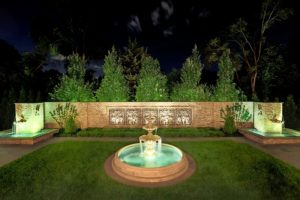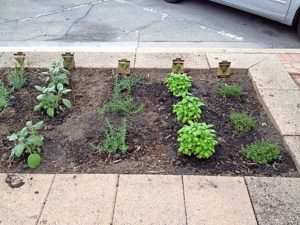Suburban Sanctuary
By Kelli Anderson
March 2017 View more Featured

It’s finally spring and along with the budding snow drops, crocus and daffodils, come new and fresh landscaping ideas for backyard living. Although outdoor kitchens and entertainment spaces continue to dominate backyard design, some of 2017’s top landscaping trends will have us relaxing more, working less and finding more personalized expressions and ways to enjoy our outdoor spaces.
Tranquility Garden
Whether you have a sixty-hour work week or are a stay-at-home parent (seldom at home), there is a new landscape trend that will have you breathing a sigh of much-needed relief: the tranquility garden.
“One of the strongest trends is the tranquility garden—a little private nook usually off the first-floor master and a sanctuary for morning coffee, mediation, an evening martini or craft beer and a cigar,” says Eric D. Bruss, APLD, president and landscape architect with Wheaton’s Bruss Landscaping, Inc., who adds that his firm is responding to growing requests for these uniquely ‘his’ or ‘her’ spaces.
Although every design is created to appeal to the unique needs and tastes of the individual, they often share some common characteristics, depending on the gender. “For men, I’m usually designing more of a rectilinear space with hardscape features and a fire element,” Bruss explains. “If it is for a woman who is excited about creating a meditation spot, or a place to have morning coffee, do yoga or read, it is often a more organic space with an enclosure of plant material instead of hardscape.”
Whatever the design, all require an important design element: convenience. While it might be romantic to envision a crackling, wood-burning fire in someone’s fortress of solitude, it is important to keep it simple. At the end of a long, hard day—or at the beginning of a new one— the effort of building a fire or frequent maintenance required for an elaborate koi pond defeats the ultimate purpose of relaxation. A natural gas fire pit or self-circulating fountain that come to life with the flip of a switch are all the complexity it takes to help turn a simple seating area into a peaceful, private, personalized oasis.
Reclaimed Hardscapes
 Personalization is key. We all want something that is a unique reflection of who we are and what we like. Hardscape garden material, for example, is taking a new cue from the recycling craze and homeowners’ desire to set themselves apart from their suburban neighbors. “Repurposing is the biggest catch phrase we are hearing,” Bruss says, “For years it was natural stone and stones from Europe or Asia. But in the last year we are starting to see an interest in local supply and repurposing—using older material like antique paver or reclaimed brick. People want to feel good about doing something good, but they also want something unique from those around them.”
Personalization is key. We all want something that is a unique reflection of who we are and what we like. Hardscape garden material, for example, is taking a new cue from the recycling craze and homeowners’ desire to set themselves apart from their suburban neighbors. “Repurposing is the biggest catch phrase we are hearing,” Bruss says, “For years it was natural stone and stones from Europe or Asia. But in the last year we are starting to see an interest in local supply and repurposing—using older material like antique paver or reclaimed brick. People want to feel good about doing something good, but they also want something unique from those around them.”
Better-quality and realistic composite materials, plus more varieties of locally sourced, affordable manufactured blocks and stone, allow more garden designs that incorporate new materials that reflect the homeowners’ unique personalities. In addition to thinking beyond limited Neapolitan flavors so typical in suburban landscape design, new projects can become a distinctive extension of house to garden, echoing the same building materials, style, and personality of the homes they surround.
Unique Softscapes
 Asking clients where they most like to go on vacation is another way designers discover unique insights and get ideas to help create a special retreat. Result? Exotic species are appearing more and more in west-suburban gardens. “We are using more tropical plants,” says Liz Holmberg of Lizzie’s Garden in Naperville. “People are willing to spend money on a rubber plant or palm tree even though they don’t live in the tropics and then they may bring them inside to overwinter—or not. The vibe is relaxing. People need to rest and these plants fit that bill, if only for a season.” Another huge trend is incorporating drought-loving succulents into our Midwestern landscapes, with their other-worldly shapes, textures and colors.
Asking clients where they most like to go on vacation is another way designers discover unique insights and get ideas to help create a special retreat. Result? Exotic species are appearing more and more in west-suburban gardens. “We are using more tropical plants,” says Liz Holmberg of Lizzie’s Garden in Naperville. “People are willing to spend money on a rubber plant or palm tree even though they don’t live in the tropics and then they may bring them inside to overwinter—or not. The vibe is relaxing. People need to rest and these plants fit that bill, if only for a season.” Another huge trend is incorporating drought-loving succulents into our Midwestern landscapes, with their other-worldly shapes, textures and colors.
Hammock Grove
 Relaxation isn’t limited to solace-seeking adults, however. It also ranks high among today’s teenager. “We come across a project now and again where people just want something unique on their property and neighborhood. One of the biggest things I’ve seen this past year was a hammock grove in a Wheaton backyard where seven to eight hammocks were suspended and the kids could hang out,” Bruss says. “The kids loved it. We had four or five requests for them last year and I think it will grow,” he predicts, adding that they are in the process of currently designing two more.
Relaxation isn’t limited to solace-seeking adults, however. It also ranks high among today’s teenager. “We come across a project now and again where people just want something unique on their property and neighborhood. One of the biggest things I’ve seen this past year was a hammock grove in a Wheaton backyard where seven to eight hammocks were suspended and the kids could hang out,” Bruss says. “The kids loved it. We had four or five requests for them last year and I think it will grow,” he predicts, adding that they are in the process of currently designing two more.
For the Birders
Baby boomers, too, becoming empty nesters and retirees, are looking to their backyard landscapes for R&R of a slightly different kind. “A growing hobby of baby boomers is bird watching,” says Carter Conlin, landscape designer with C.B. Conlin Landscapes in Naperville. “Sitting outside in the shade with a good book, waiting for your favorite cardinal to visit your bird feeder, is a nice way to spend your evening,” To that end, designers are incorporating more native plants in an effort to attract native songbirds and butterflies.
The generation is also beginning to practice a landscape philosophy that “less is less.” “Baby boomers want less in the garden,” says Bob Hursthouse, founder and president of Hursthouse Landscape Architects & Contractors in Bolingbrook, adding that as a result, popular garden designs are more simplified and easier to care for thanks, in part, to having the right native plant in the right place.
“Look at what native would grow in that area and which are easy to care for,” Hursthouse suggests, underscoring another reason for native plant appeal. “There’s the whole ecological side of the equation: helping pollinating insects, helping the monarch. If you want biodiversity, if you love cardinals, or wrens, or specific songbirds, we can design a garden to promote that.” From adding must-have native plants like the pink-blossomed, fragrant, swamp milkweed to support the lifecycle of monarch butterflies, to planting oaks to play host to many species of caterpillars loved by songbirds, gardens that attract wildlife are becoming popular for the ecologically minded of all ages, baby boomers and children alike.
Culinary Gardens
 With gardening and cooking still ranking high among America’s favorite pastimes, it only makes sense that gardeners like to grow good things to enjoy in the kitchen. “There is a renewed interest in herbs and edibles thanks to cooking shows,” Holmberg says, adding that in today’s gardens, people like to experience the touch and smell of herbs and edibles. And although full-on vegetable gardens may be a step too far for some, many are taking advantage of new hybrid plants that offer the best of both worlds, both decorative and delicious.
With gardening and cooking still ranking high among America’s favorite pastimes, it only makes sense that gardeners like to grow good things to enjoy in the kitchen. “There is a renewed interest in herbs and edibles thanks to cooking shows,” Holmberg says, adding that in today’s gardens, people like to experience the touch and smell of herbs and edibles. And although full-on vegetable gardens may be a step too far for some, many are taking advantage of new hybrid plants that offer the best of both worlds, both decorative and delicious.
“We have new patented BrazelBerries®, hybrid bushes for a blueberry and raspberry suited to our soil type,” says Hursthouse, “They are compact ornamental shrubs designed for the landscape and for fruit. Both are quite tasty.”
Whether a yard features an edible garden, exotic tropical plants, a more traditional green screen of aborvitae or a sleek stone wall to create a private enclosure, and regardless of what you call them—tranquility garden, serenity garden, personal oasis or Shangri La—designers are keen to carve out personal retreats to help us unwind, slow down, and enjoy a moment to ourselves.
Cut-ting Costs
 For Liz Holmburg, sharing her knowledge of landscape design with others is just part of the fun. With twenty-eight years of experience as a local landscape designer and gardener with Lizzie’s Garden in Naperville, she is especially encouraged by the new level of gardening interest in today’s twenty- and thirty-somethings.
For Liz Holmburg, sharing her knowledge of landscape design with others is just part of the fun. With twenty-eight years of experience as a local landscape designer and gardener with Lizzie’s Garden in Naperville, she is especially encouraged by the new level of gardening interest in today’s twenty- and thirty-somethings.
“They are so eager but no one is telling them what they should be doing—ideas that are simpler and cheaper,” she observes. This month’s seminar, Hedge Fun: Planting Shrubs for Privacy (March 25 at 2:00 p.m.), is just one of the ways interested gardeners can learn more about better, more beautiful and smarter ways to see your garden grow (visit lizziesgardencenter.com).
- Buy flats of flowers, not flowers in single, four-inch pots. You will get far more flowers for much less.
- Seeds are the biggest bang (and variety) for the buck.
- Try succulents. Popular for their ease of care and drought-tolerance, these plants have become must-have newcomers to the garden bed.
- Focus on buying healthy plants with good root systems. Make a healthy plant your first priority to avoid wasting time and money.
- Don’t buy the same plants as everyone else; go native and try plants that will attract native birds and butterflies.
- Plant decorative shrubs in containers for the summer, but don’t leave outside to overwinter in their containers, or they will die.
- Sunpatiens® are the popular new answer to the once ubiquitous, shade-loving impatients.


